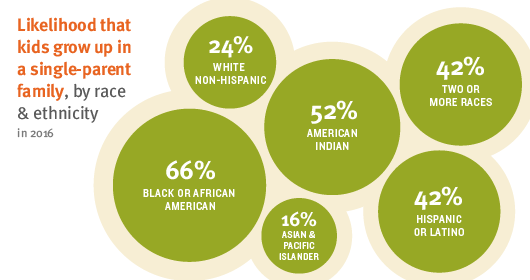Single Parents Are Raising More Than One-Third of U.S. Kids

For the last six years, the prevalence of U.S. children growing up in single-parent families has held steady at 35%. In 2016 — the most recent full year of data on record — this rate translated to more than 24 million kids having just one parent at home.
This statistic varies — and widely — by race and ethnicity. Both African American and American Indian children are more likely to live at home with one parent versus two, according to the KIDS COUNT Data Center. In 2016, 66% of all African American kids and 52% of all American Indian kids — 6.6 million children combined — hailed from single-parent families.
At the other end of the spectrum: Asian and Pacific Islander children are less likely to grow up with one parent. Sixteen percent of kids from this demographic group — 572,000 children total — have one parent at home.
Why Family Structure Matters
Kids are less likely to experience poverty when they grow up with both parents at home. For example: In 2016, 32% of single-parent families with children were living in poverty versus just 7% of two-parent families.
The literature documenting the detrimental effects of growing up poor is sweeping and strong. Some of the many challenges identified include: academic deficits, reduced access to safe communities and quality enrichment activities, and a heightened risk of physical, behavioral and emotional issues.






